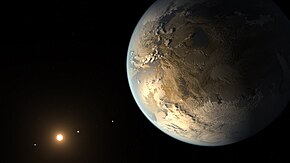 Artist’s depiction of Kepler-186f (foreground) as a rocky Earth-like planet in the habitable zone, with the Kepler-186 system visible in the background (bottom left). The actual appearance and composition of the exoplanet is not currently known. | |
| Discovery | |
|---|---|
| Discovered by | Elisa Quintana |
| Discovery site | Kepler space telescope |
| Discovery date | 17 April 2014 |
| Transit | |
| Orbital characteristics | |
| 0.432 ± 0.01 AU[1] | |
| Eccentricity | 0.04[1] |
| 129.9444 ± 0.0012 d[1] 0.355772 y | |
| Inclination | 89.9[1] |
| Star | Kepler-186 |
| Physical characteristics | |
| 1.17 ± 0.08[1] R🜨 | |
| Mass | 1.44+2.33 −1.12[2] ME |
| 1.17 (est.) g | |
| Temperature | Teq: 188 K (−85 °C; −121 °F) |
Kepler-186f[2][3] (also known by its Kepler object of interest designation KOI-571.05) is an Earth-sized exoplanet orbiting within the habitable zone of the red dwarf star Kepler-186,[4][5][6] the outermost of five such planets discovered around the star by NASA's Kepler space telescope. It is located about 580 light-years (180 parsecs) from Earth in the constellation of Cygnus.[7]
Kepler-186f orbits its star at a distance of about 0.43 AU (64,000,000 km; 40,000,000 mi) from its host star with an orbital period of roughly 130 days, and a mass and radius around 1.44 and 1.17 times that of Earth, respectively. As one of the more promising candidates for habitability, it was the first planet with a radius similar to Earth's to be discovered in the habitable zone of another star. However, key components still need to be found to determine its habitability for life, including an atmosphere and its composition and if liquid water can exist on its surface.
Analysis of three years of data was required to find its signal.[8] NASA’s Kepler space telescope detected it using the transit method (in which the dimming effect that a planet causes as it crosses in front of its star is measured), along with four additional planets orbiting much closer to the star (all modestly larger than Earth).[5] The results were presented initially at a conference on 19 March 2014[9] and some details were reported in the media at the time.[10] The planet was announced on 17 April 2014,[3] simultaneously with publication of a scientific paper in Science.[2]
- ^ a b c d e "Kepler-186 f". NASA Exoplanet Archive. Retrieved 19 July 2016.
- ^ a b c Quintana, E. V.; et al. (18 April 2014). "An Earth-Sized Planet in the Habitable Zone of a Cool Star" (PDF). Science. 344 (6181): 277–280. arXiv:1404.5667. Bibcode:2014Sci...344..277Q. doi:10.1126/science.1249403. PMID 24744370. S2CID 1892595. Archived from the original (PDF) on 18 April 2014.
- ^ a b Johnson, Michele; Harrington, J.D. (17 April 2014). "NASA's Kepler Discovers First Earth-Size Planet in The 'Habitable Zone' of Another Star". NASA. Archived from the original on 17 April 2014.
- ^ Chang, Kenneth (17 April 2014). "Scientists Find an 'Earth Twin', or Maybe a Wife". The New York Times.
- ^ a b Chang, Alicia (17 April 2014). "Astronomers spot most Earth-like planet yet". Associated Press. Archived from the original on 18 April 2014.
- ^ Morelle, Rebecca (17 April 2014). "'Most Earth-like planet yet' spotted Helper the Kepler". BBC News. Archived from the original on 18 April 2014.
- ^ Bailer-Jones, C. A. L.; et al. (August 2018). "Estimating distances from parallaxes IV: Distances to 1.33 billion stars in Gaia Data Release 2". The Astronomical Journal. 156 (2): 58. arXiv:1804.10121. Bibcode:2018AJ....156...58B. doi:10.3847/1538-3881/aacb21. S2CID 119289017. Distance to Kepler 186, after taking into account light extinction
- ^ Quintana, Elisa (17 April 2014). "Kepler 186f – First Earth-sized Planet Orbiting in Habitable Zone of Another Star". SETI Institute. Archived from the original on 18 April 2014. Retrieved 18 April 2014.
- ^ Staff (16 March 2014). "EBI – Search for Life Beyond the Solar System 2014 – Exoplanets, Biosignatures & Instruments". EBI2014. Archived from the original on 18 April 2014. Retrieved 18 April 2014. See session 19 March 2014 – Wednesday 11:50–12:10 – Thomas Barclay: The first Earth-sized habitable zone exoplanets.
- ^ Klotz, Irene (20 March 2014). "Scientists Home in on Earth-Sized Exoplanet". Discovery Communications. Archived from the original on 18 April 2014.